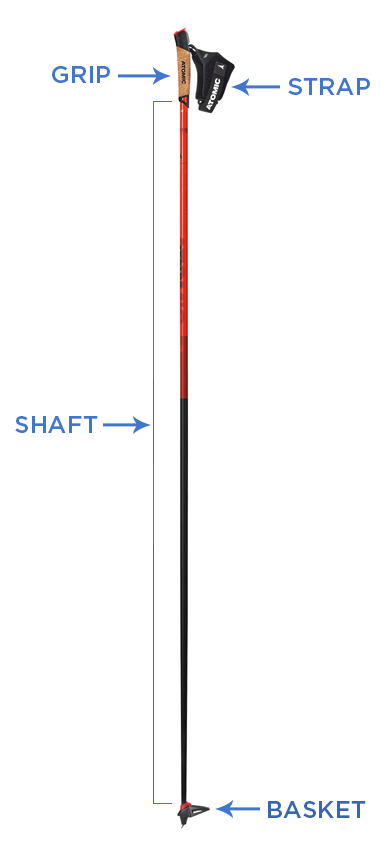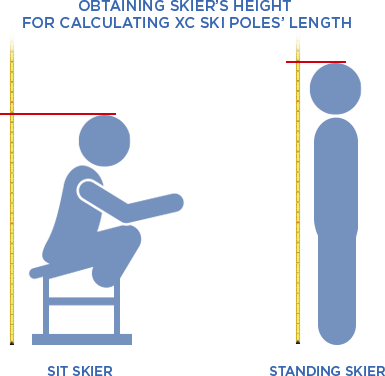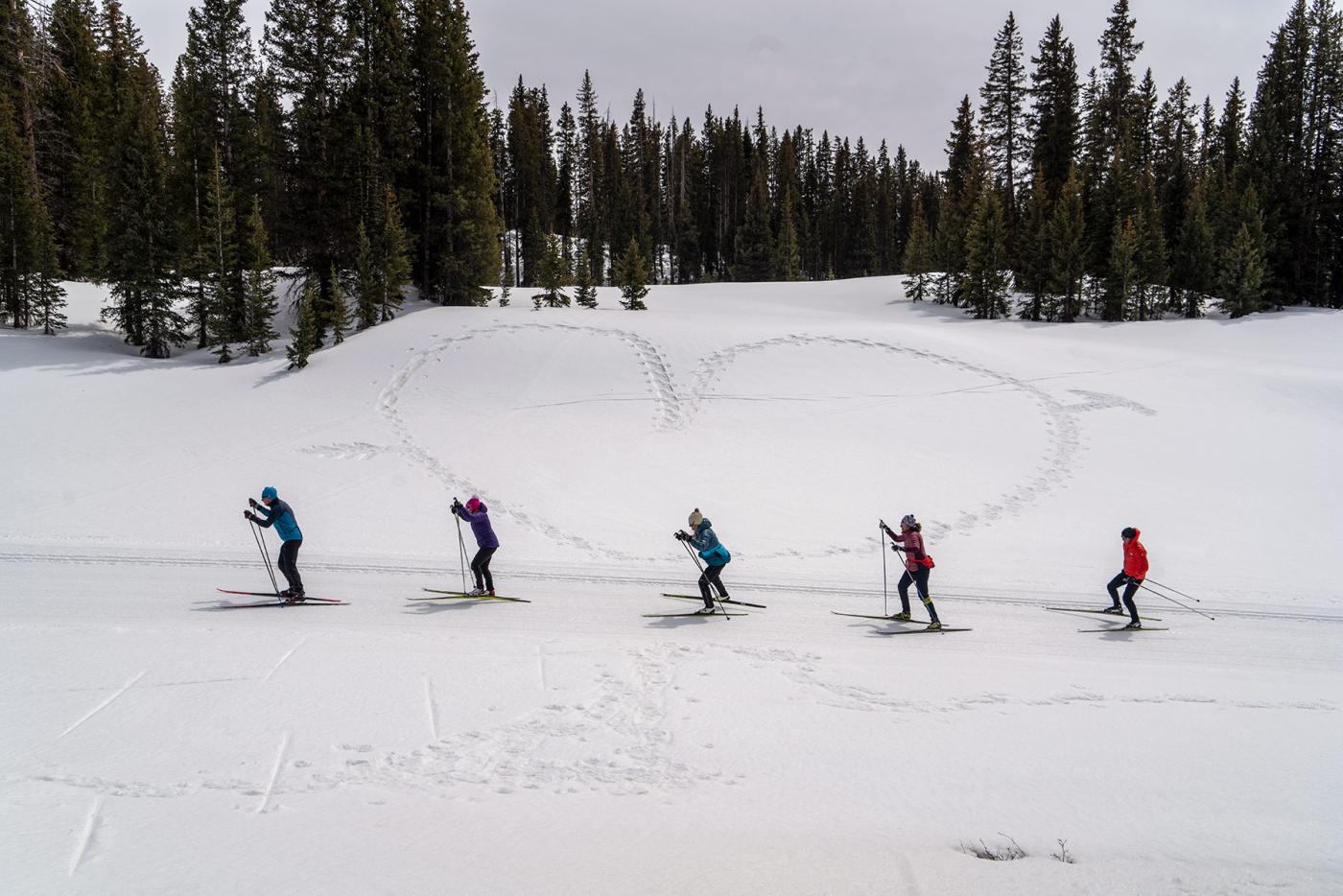The Short Version
- Use the ski pole length reference and size chart below to determine the correct length for your height.
- Grip: Plastic or cork. Cork grips are more comfortable and warmer. Plastic grips are more durable but colder and less comfortable.
- Strap: Opt for harness straps as opposed to loops as the means for attaching poles to your wrists.
- Shaft: Composite poles are lighter and more flexible than aluminum, providing value in a pole that is both light and strong. Prices range from $40-$170 a pair.
- Basket: Small or mid-size baskets for groomed trails, large baskets for touring in soft snow.
How Are the Ski Poles Used
A cross country skier uses skis and ski poles in coordinated patterns (ski techniques) to move forward. The upper body and the ski poles are used for propulsion just as much as the lower body and the skis. In addition to their role in moving the body forward, ski poles also play an important role in regulating dynamic balance.
Cross Country Ski Pole Construction
A cross country ski pole is made of four parts:
- grip
- strap
- shaft
- basket

How to Choose the Right Ski Poles
The ski poles' length, weight, means of attaching to the skier's hand, grip, and pole basket, all affect the effectiveness of the skier's efforts to move forward. Ski poles that would allow a skier to maximize their performance would be light, relatively stiff, well-engineered, and properly weighted. In the most basic selection of the ski poles, the skier's height is used to determine the optimal length of the ski poles.
Pole Length

| Classic | The pole should finish at the height of the shoulder. Formulas: skier's height minus 30 cm or the height multiplied by 0.84. |
|---|---|
| Skate | The pole should reach between the chin and upper lip. Formulas: skier's height minus about 20 cm or the height multiplied by 0.89. |
| Touring | The pole should finish below the shoulder. Formulas: skier's height minus 35 cm or the height of the skier multiplied by 0.78. |
| Sit Ski | The pole should reach between the chin and top of the head for a skier sitting in the frame (seat) with the tip of the pole in the snow. Beginners: skier's height minus 16 cm. Advanced: skier's height and up to 6 cm above the head. Typical sit ski pole length range from 105 cm to 125 cm. |
How to Measure Skier's Height
| Standing skier's height: | in bare feet, with the heels and back against the wall, from the floor to the top of the head. |
|---|---|
| Sitting skier's height: | sitting in the frame/seat, from the base/floor to the top of the head. |

Cross Country Ski Pole Length Chart for Adults
If you fall between two sizes: beginners should choose a slightly shorter pole and experienced skiers a slightly longer pole.
| Height in Centimeters | Height in Feet and Inches | Classic Pole Length in Centimeters | Skate Pole Length in Centimeters |
| 152.50 | 5' 0.00" | 122.50 | 132.50 |
| 155.00 | 5' 1.02" | 125.00 | 135.00 |
| 157.50 | 5' 2.00" | 127.50 | 137.50 |
| 160.00 | 5' 2.99" | 130.00 | 140.00 |
| 162.50 | 5' 3.97" | 132.50 | 142.50 |
| 165.00 | 5' 4.96" | 135.00 | 145.00 |
| 167.50 | 5' 5.94" | 137.50 | 147.50 |
| 170.00 | 5' 6.92" | 140.00 | 150.00 |
| 172.50 | 5' 7.91" | 142.50 | 152.50 |
| 175.00 | 5' 8.89" | 145.00 | 155.00 |
| 177.50 | 5' 9.88" | 147.50 | 157.50 |
| 180.00 | 5' 10.86" | 150.00 | 160.00 |
| 182.50 | 5' 11.85" | 152.50 | 162.50 |
| 185.00 | 6' 0.83" | 155.00 | 165.00 |
| 187.50 | 6' 1.81" | 157.50 | 167.50 |
| 190.00 | 6' 2.80" | 160.00 | 170.00 |
| 192.50 | 6' 3.78" | 162.50 | 172.50 |
| 195.00 | 6' 4.77" | 165.00 | 175.00 |
| 197.50 | 6' 5.75" | 167.50 | 177.50 |
| 200.00 | 6' 6.74" | 170.00 | 180.00 |
Cross Country Ski Pole Size Reference Guide for Kids and Youth
| Classic | Pole's maximum length: middle of the shoulder. |
|---|---|
| Skate | Pole's maximum length: to the chin, for small kids up to the armpit. |
| Touring | Pole length: about chest high. |
| Sit Ski | The pole should reach between the shoulder and middle of the forehead. |
Pole Straps

There are three types of cross country ski pole straps:
- Loop straps: Easy to use when renting for the first few ski lessons. They force the skier to grip them tightly, which is tiring, and they don't allow for a complete pole release during the final phase of pushing and during the pole return.
- Harness straps: Are comfortable and they hold the pole close to the hand allowing for lighter grip on the pole. The harness strap makes it possible to relax the hand and let go off the ski pole during the final phase of pushing and during the pole return.
- Quick-release harness straps: Same characteristics as the the harness strap but these straps disengage from the pole, making it easy for the skier to free the hands.

Loop Strap

Harness Strap

Quick-Release Harness Strap
There is an advantage to using harness straps as they allow a skier to hold the pole both with more control and more comfortably than with loop straps. At the end of each pole stroke (push) a skier can stop gripping the pole for the duration of the returning (swinging) the pole back to that start position of the new pole stroke. Releasing the grip on the pole allows a hand to relax after each pole stroke providing moments of rest and less obstructed blood flow to keep hands warm. When using a strap you won't lose control of the pole when releasing the grip at the end of your pole stroke.
Pole Grips

There are two types of cross country ski pole grips:
Pole Shafts

Material
Composite or carbon fiber ski poles offer the best combination of weight, durability and stiffness for cross country skiing.
- Aluminum: Although aluminum ski poles are sturdy and hard to break, making them very reliable, they are heavy and often poorly weighted resulting in quick onset of a skier's muscle fatique. Prices range from $20-$40 a pair.
- Composite material: Composite poles are lighter and more flexible than aluminum making them suitable for beginners and intermediate skiers looking for a value in a pole that is both light and strong. Prices range from $40-$170 a pair.
- Carbon fiber: Carbon ski poles are very sturdy, rigid and light, and they offer the best performance through the combination of weight, stiffness for transferring power and ease of balancing of the pole in the hand. Carbon fiber poles are suitable for competitors and skiers looking for high performance. Prices range from $160 a pair for a combination carbon fiber and carbon poles to $500 a pair for high-modulus carbon poles.
Shaft Weight
When buying composite or carbon fiber poles, the technical specifications would typically express the pole's weight in grams per one meter length of the ski pole shaft.
Example weight on a 150 cm ski pole:
- a very light carbon ski pole with weight specification of 56 gr/m would weigh 168 grams
- a much heavier aluminum pole could weigh as much as 1,000 grams (1 kg), nearly six times as much as a carbon composite pole
In cross-country skiing, after propelling yourself forward and pushing back on your poles, you need to bring the poles back in front of you in a swinging motion. A higher-end poles are weighted at the top, which has a positive impact on the swing and the balance of the pole.
Pole Baskets

There are three types of cross country ski pole baskets:
References:
- Sources: 35th Conference of the International Society of Biomechanics in Sports, Cologne, Germany, June 14-18, 2017, Biomechanical characteristics related to poling propulsive effectiveness in cross-country V2 skating technique.
- Comparison of Exclusive Double Poling to Classic Techniques of Cross-country Skiing, Nov 8, 18, US National Library of Medicine National Institutes of Health
- Effect Of Ski Pole Stiffness On Upper Body Power Output In Cross-country Skiers, May 2009, Erik A. Jacobson, Robert Pickels, University of Colorado Boulder, Daniel Heil, Montana State University

